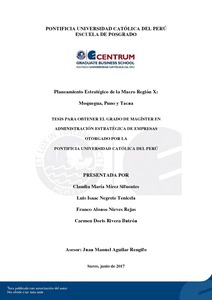| dc.contributor.advisor | Aguilar Rengifo, Juan Manuel | |
| dc.contributor.author | Mírez Sifuentes, Claudia María | es_ES |
| dc.contributor.author | Negrete Tenicela, Luis Isaac | es_ES |
| dc.contributor.author | Nieves Rejas, Franco Alonso | es_ES |
| dc.contributor.author | Rivera Butrón, Carmen Doris | es_ES |
| dc.date.accessioned | 2017-07-17T16:00:46Z | |
| dc.date.available | 2017-07-17T16:00:46Z | |
| dc.date.created | 2017 | |
| dc.date.issued | 2017-07-17 | |
| dc.identifier.uri | http://hdl.handle.net/20.500.12404/9045 | |
| dc.description.abstract | Este documento sigue el Proceso Estratégico según el Modelo Secuencial diseñado por
D’Alessio (2015) y está dirigido en su aplicación a la Macro Región R10 del Perú, integrada
por los departamentos de Tacna, Moquegua y Puno. Se propone que, para el año 2027, esta
pueda ser reconocida como el principal productor de quinua a nivel mundial, ubicándose
dentro de los cinco primeros productores de aceituna en el mundo y siendo competitiva
también en la extracción de cobre, así como en el turismo receptivo nacional y extranjero,
elevando el nivel de calidad de vida de una manera socialmente responsable. Esta visión se
traduce en objetivos de largo plazo, cuantitativos, alcanzables y retadores, todos ellos al
2027: (a) las ventas de aceitunas alcanzarán US$ 166.3 millones, partiendo de los US$ 71.3
millones vendidos en el año 2016; (b) la venta de quinua llegará a US$ 375 millones,
sabiendo que para el 2015 hubo ventas por US$ 35.1 millones; (c) se explotarán recursos de
cobre por un valor de US$ 2,654 millones, a partir de los US$ 1,119 millones que se
explotaron en el 2014; (d) alcanzar ingresos por turismo de US$ 6,440 millones a partir de los
US$ 2,101 millones generados en el 2015; (e) alcanzar un Valor Agregado Bruto de S/
36,600 millones en valor constante del 2007, partiendo de un VAB igual a S/ 23,822 millones
en el 2014; (e) reducir la pobreza a menos del 10%, sabiendo que en el 2015 era 29.4%. Para
lograr estos objetivos, se consideran como fortalezas los atractivos turísticos, las tierras
fértiles con cultivos y los distintos recursos naturales. La manera en que se lograrán los
objetivos es mediante estrategias intensivas, que han sido cuidadosamente analizadas y
enfocadas en el desarrollo de productos y de mercados, contemplando la penetración en estos
últimos | es_ES |
| dc.description.abstract | Using the Sequential Model designed by D'Alessio (2015), the Strategic Process was
followed to create this document for the Macro Region R10 of Peru, integrated by the
departments of Tacna, Moquegua and Puno. It is proposed a vision for the year 2027, which
will allow Macro Region R10 to be recognized as the main producer of quinoa worldwide, be
in the top five producers of olives worldwide, being competitive also in the extraction of
copper, as well as in domestic and foreign receptive tourism, which will allow its inhabitants
to have a high level of quality of life, with human development in a socially responsible way.
This vision translates into long-term, quantitative, achievable and challenging objectives: (a)
sales of olives will reach US$ 166.3 million, starting from US$ 71.3 million sold in 2016; (b)
the sale of quinoa will reach US$ 375 million, knowing that by 2015 there were sales of US$
35.1 million; (c) copper resources will be exploited and sold for US $ 2.654 million, from US
$ 1.119 million that were exploited in 2014; (d) reach increases for turism from US$ 6,440
million, starting of US$ 2,101 millions in 2015; (e) reach a Gross value added from S/ 36,600
millions in constant value from 2007, starting of a Gross value added from S/ 23,822 millions
in 2014; (f) reduce poverty under 10%, knowing that in 2015 it was 29.4%. In order to
achieve all these goals, there will use of the strengths that have, among which the attractions
Tourism, fertile lands with crops of olives and other products and different natural resources.
The way in which the objectives will be achieved is through intensive strategies, which have
been carefully analyzed, focusing on product development, market development and
penetration in the markets where it is currently present | es_ES |
| dc.language.iso | spa | es_ES |
| dc.publisher | Pontificia Universidad Católica del Perú | es_ES |
| dc.rights | info:eu-repo/semantics/openAccess | es_ES |
| dc.rights.uri | http://creativecommons.org/licenses/by-nc-nd/2.5/pe/ | * |
| dc.subject | Planificación regional -- Perú -- Puno | es_ES |
| dc.subject | Planificación regional -- Perú -- Tacna | es_ES |
| dc.subject | Planificación estratégica | es_ES |
| dc.title | Planeamiento estratégico de la macro región X: Moquegua, Puno y Tacna | es_ES |
| dc.type | info:eu-repo/semantics/masterThesis | es_ES |
| thesis.degree.name | Maestro en Administración Estratégica de Empresas | es_ES |
| thesis.degree.level | Maestría | es_ES |
| thesis.degree.grantor | Pontificia Universidad Católica del Perú. CENTRUM | es_ES |
| thesis.degree.discipline | Administración Estratégica de Empresas | es_ES |
| renati.discipline | 413307 | es_ES |
| renati.level | https://purl.org/pe-repo/renati/level#maestro | es_ES |
| renati.type | https://purl.org/pe-repo/renati/type#tesis | es_ES |
| dc.publisher.country | PE | es_ES |
| dc.subject.ocde | https://purl.org/pe-repo/ocde/ford#5.02.04 | es_ES |






